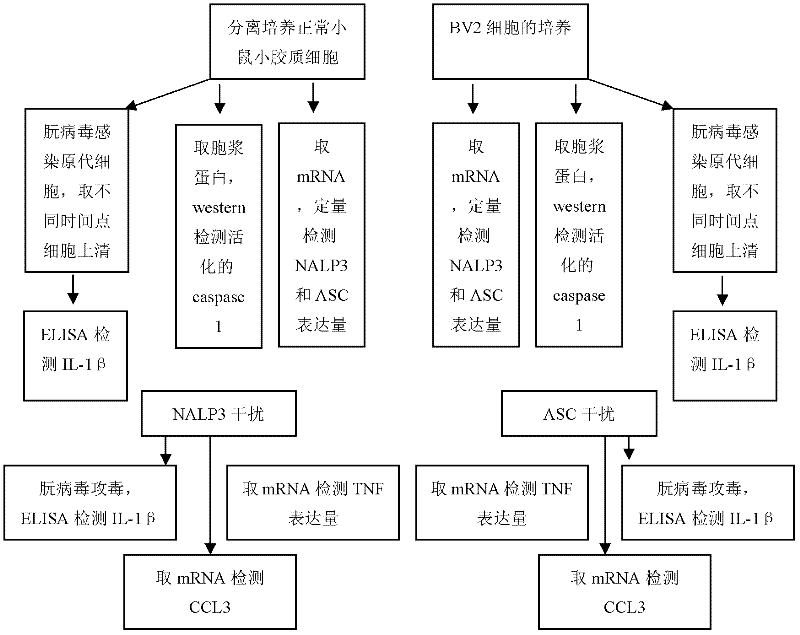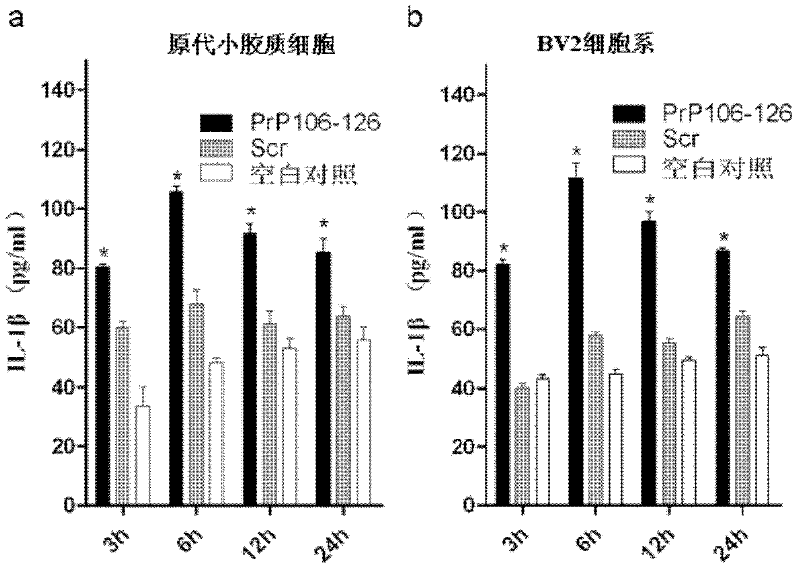Application of NALP3-ASC inflammation complex and activator inhibitor thereof in terms of preparation of medicines for treating prion diseases
A NALP3-ASC, 1. NALP3-ASC technology, applied in the field of application of NALP3-ASC inflammatory complex and its activation inhibitor in the preparation of prion disease drugs, can solve the problem of not elucidating the activated state of neuroglial cells And other issues
- Summary
- Abstract
- Description
- Claims
- Application Information
AI Technical Summary
Problems solved by technology
Method used
Image
Examples
Embodiment 1
[0050] Example 1 The role of NALP3-ASC inflammatory complex in prion-induced cell release of IL-1β
[0051] 1. Materials and methods
[0052] 1.1 Reagents
[0053] Rabbit anti-mouse caspase1, NALP3 and ASC antibodies were purchased from BioVision, Abcam and Santa Cruz, respectively; rabbit anti-mouse NF-kappaB p65 antibody, βactin and Max antibodies were purchased from Beyontian; LPS and N-acetylcysteine (NAC ) was purchased from Sigma, IL-1β detection kit and protein rapid precipitation and concentration kit were purchased from Wuhan Boster Company; goat anti-rabbit secondary antibody, Bay 11-7082 were purchased from Beyond Biotechnology Company.
[0054] 1.2 Isolation and culture of microglia
[0055] The isolation of primary cells was carried out according to the existing literature (Kingham PJ, Cuzner ML, Pocock JM. 1999. Apoptotic pathways mobi-lized in microglia and neurones as a consequence of chromogranin A-induced microglial activation. J Neurochem73: 538-547) op...
Embodiment 2
[0091] Example 2K + Solution and reactive oxygen species (ROS) inhibitor NAC reduces IL-1β secretion by inhibiting the expression of NALP3 and ASC
[0092] Using high concentration (130mM) of KCL and ROS inhibitor NAC at a concentration of 10μM to act on the cells respectively, and detecting the effect of BV2 cells on the NALP3 inflammatory complex after being challenged by PrP106-126 under the action of these two reagents influences.
[0093] 100 μM PrP106-126 co-stimulated the cells with 130 mM KCL and 10 μM NAC, respectively. After 6 hours, the supernatant of the cells was taken to detect IL-1β. ELISA results showed that both KCL and NAC could significantly inhibit the production of IL-1β ( Figure 8 ), in addition, the total RNA of cells after treatment was taken, and the changes of NALP3 and ASC were detected by qPCR. The primers used were:
[0094] NALP3, upstream: 5'-ATTACCCGCCCGAGAAAGG-3',
[0095] Downstream: 5'-TCGCAGCAAAGATCCACACAG-3';
[0096] ASC, upstream: 5...
Embodiment 3
[0100] Example 3 Screening of NALP3-ASC Inflammatory Complex Activation Inhibitors
[0101] 1. Processing of samples to be tested
[0102] Take KCL and NAC chemical analysis pure grade powder, and dilute to the working concentration with PBS, which are 130mM and 10μM respectively.
[0103] 2. Screening method establishment
[0104] Stimulate the BV2 cells with the sample to be tested and the prion neurotoxic fragment PrP106-126, extract the total RNA of the treated cells, use qPCR to detect the NALP3-ASC inflammatory complex, and judge the mRNA expression of NALP3 and ASC according to the PCR amplification results Inhibition situation, screening the test samples that can inhibit the expression of NALP3 and ASC is the anti-Prion disease drug.
[0105] The primers used to detect NALP3 and ASC by qPCR method are:
[0106] NALP3, upstream: 5'-ATTACCCGCCCGAGAAAGG-3',
[0107] Downstream: 5'-TCGCAGCAAAGATCCACACAG-3';
[0108] ASC, upstream: 5'-GCAACTGCGAGAAGGCTAT-3',
[0109] ...
PUM
 Login to View More
Login to View More Abstract
Description
Claims
Application Information
 Login to View More
Login to View More - Generate Ideas
- Intellectual Property
- Life Sciences
- Materials
- Tech Scout
- Unparalleled Data Quality
- Higher Quality Content
- 60% Fewer Hallucinations
Browse by: Latest US Patents, China's latest patents, Technical Efficacy Thesaurus, Application Domain, Technology Topic, Popular Technical Reports.
© 2025 PatSnap. All rights reserved.Legal|Privacy policy|Modern Slavery Act Transparency Statement|Sitemap|About US| Contact US: help@patsnap.com



